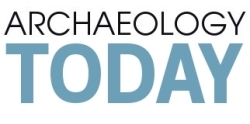
December 5th, 2013
Scientists Sequence 400,000-Year-Old Hominin DNA
Researchers at the Max Planck Institute for Evolutionary Anthropology in Leipzig, Germany, have successfully sequenced a complete mitochondrial (mtDNA) genome of a 400,000-year-old representative of the genus Homo from Sima de los Huesos, a cave site in northern Spain that has yielded some of the earliest fossil specimens of humans in present-day Europe. They found that the ancient individual was related to Denisovans, extinct relatives of Neanderthals in Asia, through a common ancestor. (Popular Archaeology)
Ancient Tomb of Chimú Nobles Found in Peru
Archaeologists working at the site of an ancient town in the coastal desert of northern Peru made a surprising discovery in late August—a multichamber tomb from the much later Chimú culture that held the remains of at least four noble musicians and weavers. Two human sacrifices, seen in this photo, accompanied the tomb’s elite occupants into eternity. The site of Samanco spreads over some 75 acres in the Nepeña River valley. Most of its ruins belong to a small trading community that flourished between 800 and 200 B.C. (National Geographic)
December 3rd, 2013
New Clues About Human Sacrifices at Ancient Peruvian Temple
Human-sacrifice rituals at an ancient Moche temple in Peru likely featured the killing of war captives from distant valleys, according to an analysis of bones and teeth at the site. The human remains—mutilated, dismembered, and buried in pits—help explain territorial struggles among the Moche, who ruled Peru’s arid coast from around 100 A.D. to 850 A.D. (National Geographic)
A well-known historical site in Nepal may gain even more significance after archeologists found evidence linking the site of the temple with the birth of Buddha in the sixth century B.C.. Most historical records link Buddhism’s origins with the fifth or sixth century B.C. But according to the researchers working at this site, their findings are the first to link the life of Buddha with a specific century. (SummitCountyVoice)
Dedication To the Lord of Death Found at Tehuacan
Dedicated to Mictlantecuhtli or Lord of Death, archaeologists from the National Institute of Anthropology and History (INAH) investigated a shrine thought to be of mid-fourteenth century date located 20 metres to the south of the Great Temple at the site of Tehuacan in Puebla, Mexico. (Past Horizons)
Paleolithic Cave Painters in Europe were Mostly Women, Researcher Says
The assumption has been that handprints, whether stencils – paint blown around the hand – or actual paint-dipped prints, were produced by men because other images on cave walls were often hunting scenes. The smaller handprints were assumed to be adolescent boys. Prof Snow came across the work of Liverpool University scientist Dr John Manning, who about 10 years ago tried to use the relationships of various hand measurements to determine not only sex, but such things as sexual preference or susceptibility to heart disease. Prof Snow wondered if he could apply this method to the handprints left in cave sites in Europe. (Sci-News.com)
Remains of 18 people found on dig medieval dig in Durham
The skeletons 18 people have been unearthed at a mass medieval burial site near Durham Cathedral. At first archaeologists thought the remains were part of the cathedral’s cemetery but then realised they had been “tipped” into the ground. They were found during work on Durham University’s Palace Green library. (BBC News)
Shaanxi skull find shows women were sacrificed in ancient China
Archaeologists in China have unearthed the skulls of more than 80 young women who may have been sacrificed more than 4,000 years ago, state media reported on Monday. The skulls were found in what appears to have been a mass grave at the Shimao Ruins, the site of a neolithic stone city in the northern province of Shaanxi. (South China Morning Post)
Archaeologists discover Chachapoyas sarcophagi in Amazonas, Peru
Diminutive size of sarcophagi has led archaeologists to believe that it may be a cemetery exclusively for children. Archaeologists working in the Amazonas region of Peru have discovered 35 sarcophagi belonging to the Chachapoyas culture. Peru21 reports that the find was made this past July with the help of a super long zoom camera. In September, researchers were able to reach the site to confirm the find and discovered that the sarcophagi were only about 70 centimeters tall on average. Researchers believe that the group of sarcophagi may constitute a cemetery in which only children were buried. (PeruThisWeek)
Archaeologists discover slave artifacts where Ga. highway project will cross plantation site
A Mexican coin punctured with a small hole, nails from long-decayed wooden dwellings, and broken bits of plates and bottles are among thousands of artifacts unearthed from what archaeologists suspect were once slave quarters at the site of a planned highway project in Savannah. (Tribtown.com)
Researchers plan for Ice Age dig in Vero Beach
Officials are signing an agreement that will allow an archaeological dig to move forward in Vero Beach The agreement being signed Monday will allow researchers from a Pennsylvania university to excavate a site where Ice Age fossils of animals were discovered almost 100 years ago. Along with evidence of mastodons and saber-tooth cats, archaeologists found human remains that they named “Vero Man.” (WinkNews)





